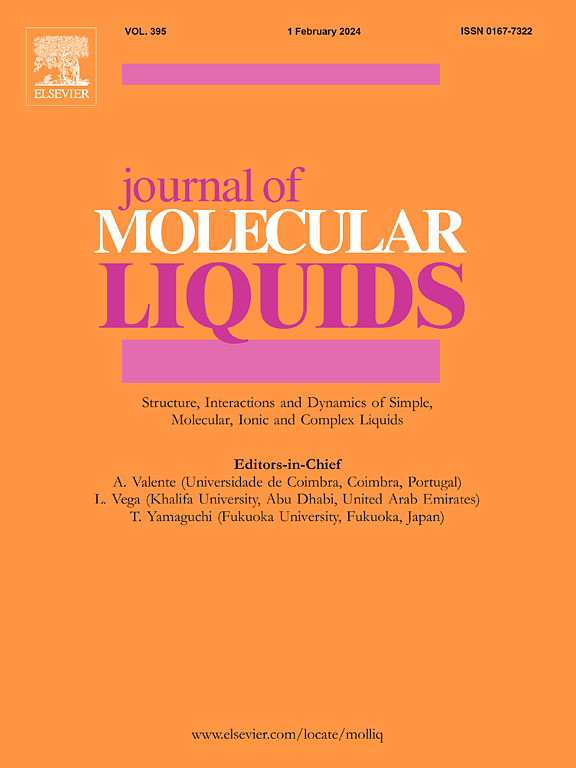n -甲基二乙醇胺(MDEA)存在下CO2在四丁基溴化铵(TBAB)和乙二醇深共晶溶剂中的溶解度:实验研究和热力学模型
IF 5.3
2区 化学
Q2 CHEMISTRY, PHYSICAL
引用次数: 0
摘要
对高效二氧化碳捕获技术日益增长的需求刺激了对新型溶剂作为传统方法替代品的研究。虽然离子液体具有广阔的应用前景,但其高昂的成本和复杂的合成工艺阻碍了离子液体的广泛应用。深共晶溶剂(DESs)是一种由氢键供体和受体简单混合形成的溶剂,是一种成本效益高且易于合成的二氧化碳吸收候选者。其特点是熔点低于其组分,在环境条件下可以存在于液相中。实验研究了CO2在由四丁基溴化铵(TBAB)和乙二醇(EG)以1:4 M比组成的特定DES中的溶解度,温度分别为313.15 K、328.15 K和343.15 K,压力范围为0.1-5 MPa。为了进一步提高CO2的吸收,还评估了在DES中加入浓度为5%、10%和15%的甲基二乙醇胺(MDEA)的效果。实验结果表明,随着压力的增加和温度的降低,CO2吸收量显著增加。值得注意的是,加入MDEA后,DES + MDEA混合物的CO2吸收能力明显提高。采用Soave-Redlich-Kwong (SRK)状态方程和非随机双液(NRTL)模型对所研究体系的气液平衡数据进行了热力学建模。模型预测和实验数据之间的极好一致性突出了TBAB:EG (DES)的巨大潜力,特别是在与MDEA增强后,用于有效的二氧化碳捕获应用。本文章由计算机程序翻译,如有差异,请以英文原文为准。
CO2 solubility in tetrabutyl ammonium bromide (TBAB) and ethylene glycol deep eutectic solvents in the presence of N-methyl diethanolamine (MDEA): experimental study and thermodynamic modeling
The growing need for efficient carbon dioxide (CO2) capture technologies has spurred research into novel solvents as alternatives to traditional methods. While ionic liquids (ILs) have shown promise, their high cost and complex synthesis hinder widespread application. Deep eutectic solvents (DESs), formed by simple mixing of a hydrogen bond donor and acceptor, have emerged as cost-effective and readily synthesized candidates for CO2 absorption. Characterized by melting points lower than their components, DESs can exist in the liquid phase under ambient conditions. This study experimentally investigated the solubility of CO2 in a specific DES composed of TetraButyl Ammonium Bromide (TBAB) and ethylene glycol (EG) in a 1:4 M ratio at temperatures of 313.15 K, 328.15 K, and 343.15 K, across a pressure range of 0.1–5 MPa. To further enhance CO2 uptake, the effect of incorporating Methyl DiEthanolAmine (MDEA) at concentrations of 5, 10, and 15 wt% into the DES was also evaluated. The experimental results demonstrated a significant enhancement in CO2 absorption with increasing pressure and decreasing temperature. Notably, the addition of MDEA led to a marked improvement in the CO2 absorption capacity of the DES + MDEA mixture. Vapor-liquid equilibrium data for the studied systems were thermodynamically modeled using the Soave-Redlich-Kwong (SRK) equation of state for the vapor phase fugacity and the Non-Random Two-Liquid (NRTL) model for the liquid phase activity coefficients. The excellent agreement between the model predictions and the experimental data highlights the significant potential of TBAB:EG (DES), particularly when enhanced with MDEA, for efficient CO2 capture applications.
求助全文
通过发布文献求助,成功后即可免费获取论文全文。
去求助
来源期刊

Journal of Molecular Liquids
化学-物理:原子、分子和化学物理
CiteScore
10.30
自引率
16.70%
发文量
2597
审稿时长
78 days
期刊介绍:
The journal includes papers in the following areas:
– Simple organic liquids and mixtures
– Ionic liquids
– Surfactant solutions (including micelles and vesicles) and liquid interfaces
– Colloidal solutions and nanoparticles
– Thermotropic and lyotropic liquid crystals
– Ferrofluids
– Water, aqueous solutions and other hydrogen-bonded liquids
– Lubricants, polymer solutions and melts
– Molten metals and salts
– Phase transitions and critical phenomena in liquids and confined fluids
– Self assembly in complex liquids.– Biomolecules in solution
The emphasis is on the molecular (or microscopic) understanding of particular liquids or liquid systems, especially concerning structure, dynamics and intermolecular forces. The experimental techniques used may include:
– Conventional spectroscopy (mid-IR and far-IR, Raman, NMR, etc.)
– Non-linear optics and time resolved spectroscopy (psec, fsec, asec, ISRS, etc.)
– Light scattering (Rayleigh, Brillouin, PCS, etc.)
– Dielectric relaxation
– X-ray and neutron scattering and diffraction.
Experimental studies, computer simulations (MD or MC) and analytical theory will be considered for publication; papers just reporting experimental results that do not contribute to the understanding of the fundamentals of molecular and ionic liquids will not be accepted. Only papers of a non-routine nature and advancing the field will be considered for publication.
 求助内容:
求助内容: 应助结果提醒方式:
应助结果提醒方式:


